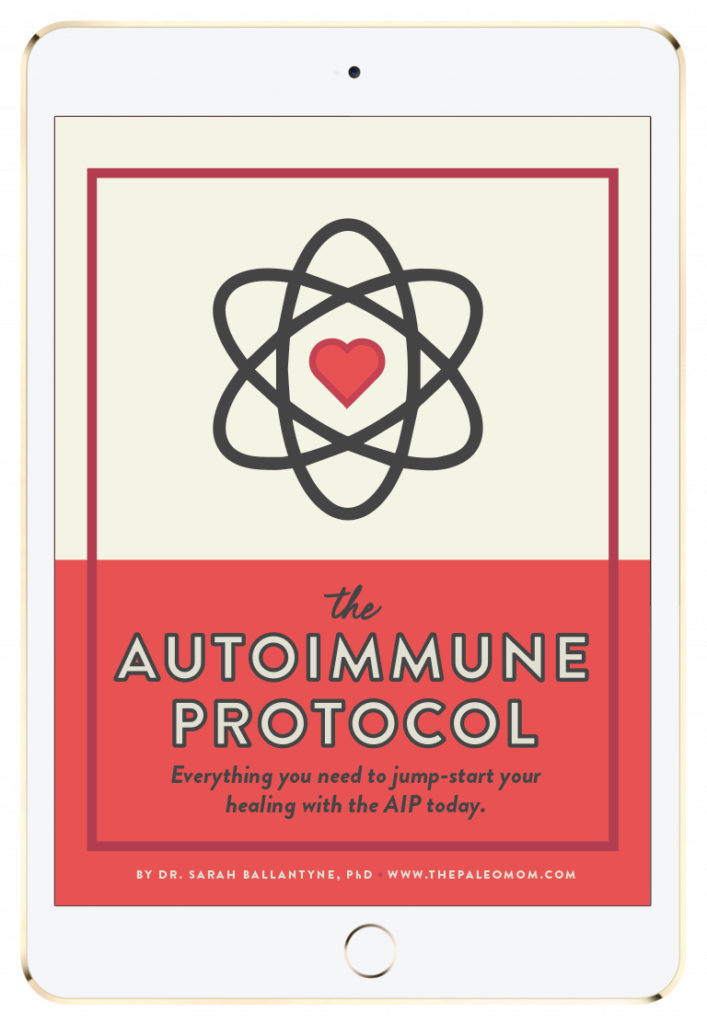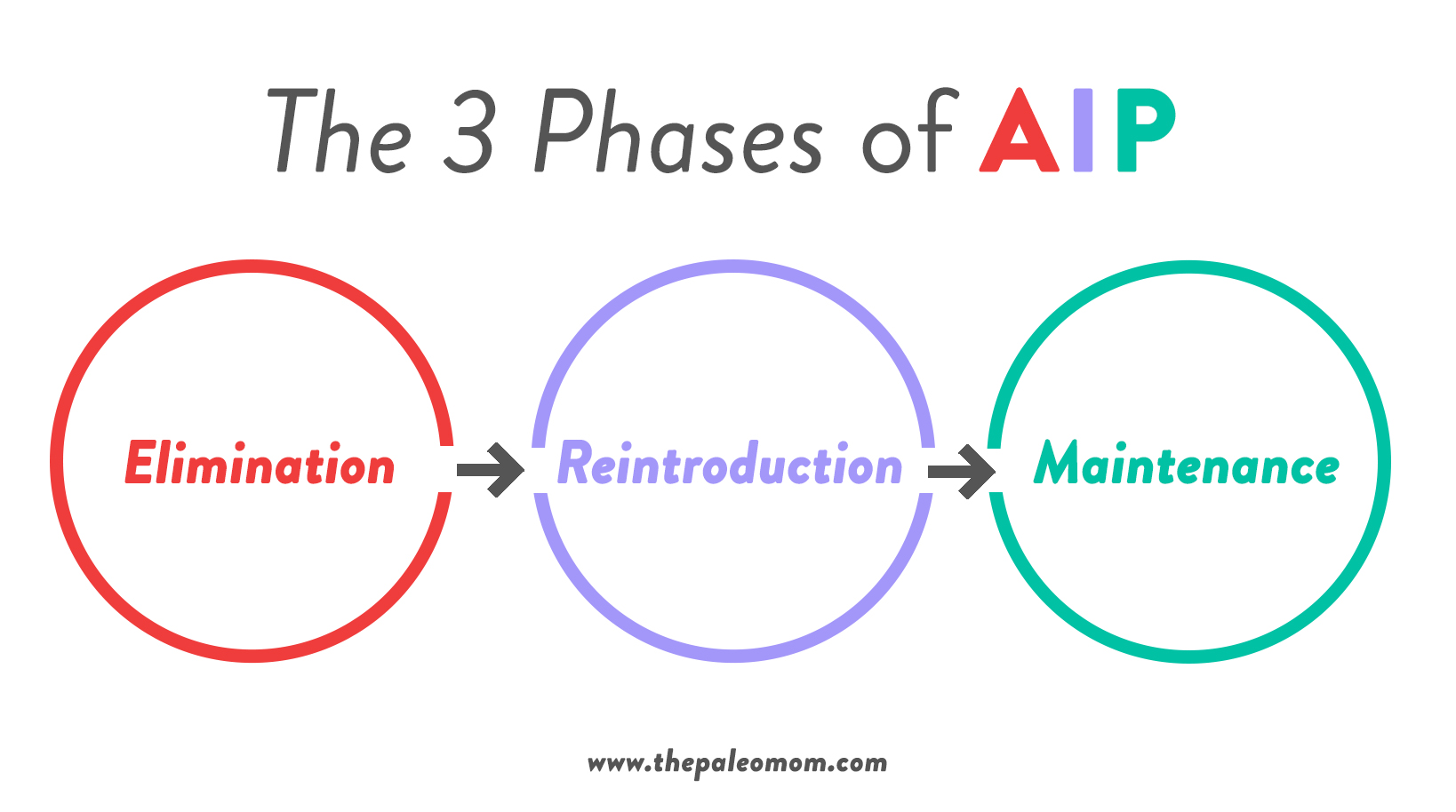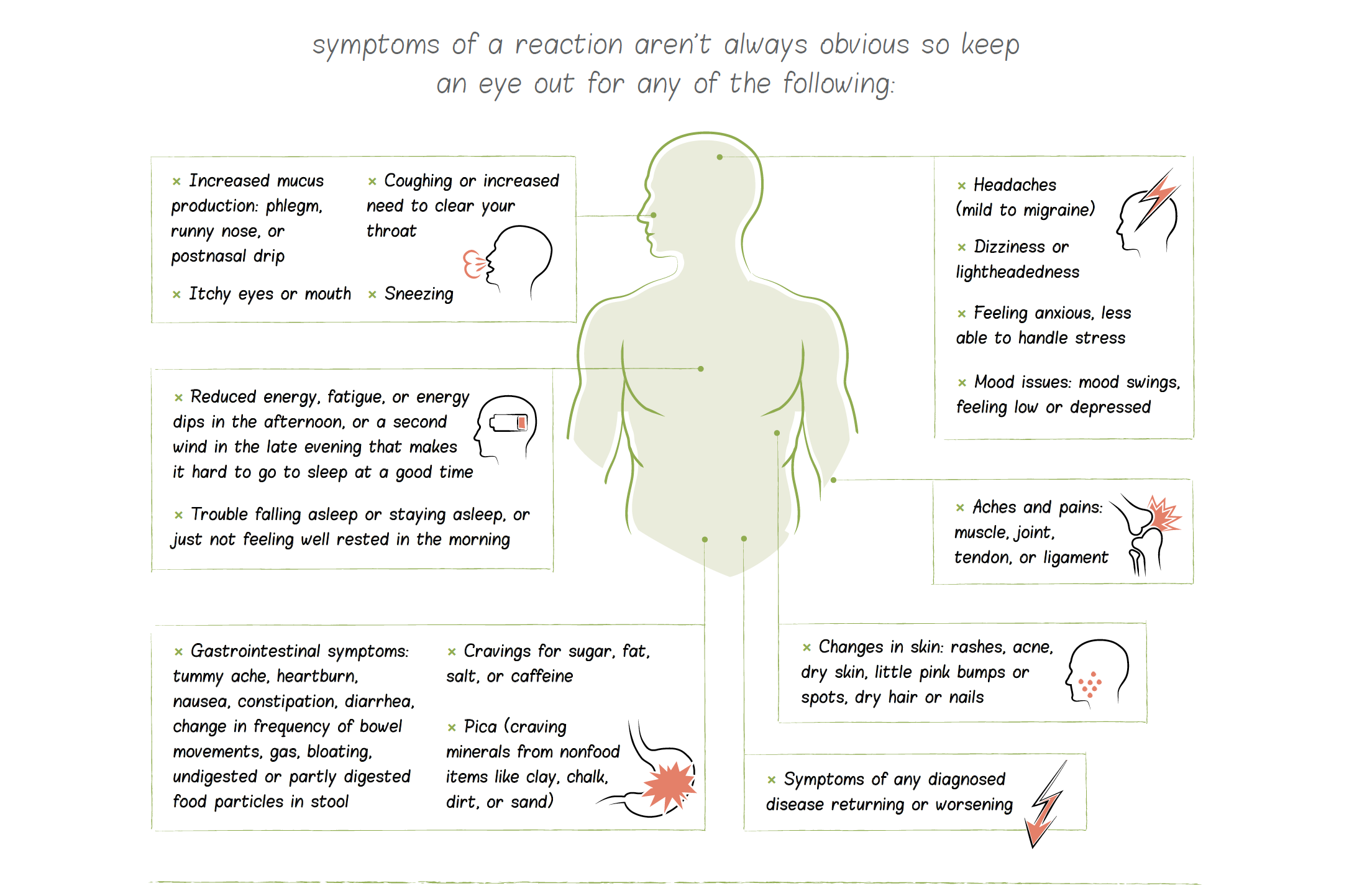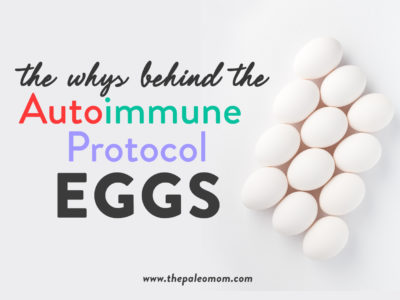 Autoimmune disease is an epidemic in our society, affecting an estimated 50 million Americans. There are more than a hundred confirmed autoimmune diseases—some of the most common being Graves’ disease, Hashimoto’s thyroiditis, systemic lupus erythematosus, rheumatoid arthritis, multiple sclerosis, Sjögren’s syndrome, alopecia areata, psoriasis, ulcerative colitis, Crohn’s disease, and type 1 diabetes—and many more diseases that are suspected of having autoimmune origins. Although each condition brings unique symptoms, the root cause of all autoimmune diseases is the same: our immune system, which is supposed to protect us from invading microorganisms, turns against us and attacks our own proteins, cells, and tissues instead. Which proteins, cells, and tissues are attacked determines the specific autoimmune disease and its symptoms. For example, in Hashimoto’s thyroiditis, the thyroid gland is attacked. In rheumatoid arthritis, the tissues of the joints are attacked. In psoriasis, proteins within the layers of skin cells are attacked.
Autoimmune disease is an epidemic in our society, affecting an estimated 50 million Americans. There are more than a hundred confirmed autoimmune diseases—some of the most common being Graves’ disease, Hashimoto’s thyroiditis, systemic lupus erythematosus, rheumatoid arthritis, multiple sclerosis, Sjögren’s syndrome, alopecia areata, psoriasis, ulcerative colitis, Crohn’s disease, and type 1 diabetes—and many more diseases that are suspected of having autoimmune origins. Although each condition brings unique symptoms, the root cause of all autoimmune diseases is the same: our immune system, which is supposed to protect us from invading microorganisms, turns against us and attacks our own proteins, cells, and tissues instead. Which proteins, cells, and tissues are attacked determines the specific autoimmune disease and its symptoms. For example, in Hashimoto’s thyroiditis, the thyroid gland is attacked. In rheumatoid arthritis, the tissues of the joints are attacked. In psoriasis, proteins within the layers of skin cells are attacked.
Table of Contents[Hide][Show]
Although genetic predisposition accounts for approximately one-third of the risk of developing an autoimmune disease, the other two-thirds comes from diet, lifestyle, and environmental factors (discussed in detail in The Paleo Approach and the AIP Lecture Series). In fact, experts are increasingly recognizing that certain dietary factors are key contributors to autoimmune disease, placing these autoimmune conditions in the same class of diet- and lifestyle-related diseases as type 2 diabetes, cardiovascular disease, and obesity. That means that in many cases, managing autoimmune disease and preventing (or at least minimizing) flares is within our power.
Because the Paleo diet naturally eliminates a number of autoimmune triggers (including foods that cause or aggravate a leaky gut, see Which Comes First: The Leaky Gut or the Dysfunctional Immune System?) while including key nutrients that support healthy immune and hormone function, simply adopting a Paleo diet may lead to noticeable improvements in symptoms. However, a modified form of Paleo called the Autoimmune Protocol (abbreviated AIP) takes the therapeutic potential of Paleo even further. The AIP is a powerful strategy that uses both diet and lifestyle to regulate the immune system, giving the body the opportunity to heal.
It’s important to emphasize that the AIP dietary framework is not a one-size-fits-all diet that autoimmune disease sufferers are doomed to follow for their entire lives.
In fact, the AIP can more accurately be described as a sophisticated elimination and challenge diet that embraces self-discovery via its reintroduction phase and respects bioindividuality via its maintenance phase. In this regard, the AIP is more like a step-by-step plan to help you identify your autoimmune disease triggers, truly understand the diet and lifestyle requirements of your own body, and hone in on a personalized diet and lifestyle plan that is optimal for you as an individual and sustainable for your entire life. You can think of the Autoimmune Protocol as encompassing three phases: Elimination, Reintroduction and Maintenance.

Elimination Phase
What many people refer to as the Autoimmune Protocol is merely the first phase of this approach, also termed the Elimination Phase (like most AIP leaders, I too am guilty of using the term AIP as a shorthand for AIP Elimination Phase).
The term Elimination Phase can be misleading though, because this first phase of the AIP puts a humongous amount of emphasis on nutrient-density, meaning that the benefits of the AIP are at least equally (if not more so) attributable to the wide variety of nutrition-packed foods that we eat rather than the dietary toxins and autoimmune triggers that we avoid during this AIP phase. In addition, the AIP is also a holistic approach to health, including not only a dietary framework but also a focus on lifestyle factors known to be important modulators of immune function, gut health, and hormone health. The Elimination Phase of the AIP also includes a strong focus on getting adequate sleep, managing stress, nature time, connection, social networks, and living an active lifestyle while avoiding overtraining.
Where the AIP Elimination Phase name is earned is in the list of foods typically allowed on the Paleo diet that are additionally eliminated in this AIP phase due to containing compounds that may stimulate the immune system or harm the gut environment, including nightshades (like tomatoes and peppers), eggs, nuts, seeds, and alcohol (see The Autoimmune Protocol for more information). The dual goal of the AIP Elimination Phase diet is to flood the body with nutrients while avoiding any food that might be contributing to disease (or at the very least interfering with efforts to heal).
The Elimination Phase is also a good time for refinement and troubleshooting, if needed. While some people experience remarkable recovery within a short period of time of starting the AIP (clinical remission was achieved in 73% of inflammatory bowel disease sufferers within 6 weeks of a gradual transition to the AIP in a 2017 study!!!), others require additional interventions before their health really starts to turn around. Diet and lifestyle changes can’t fix everything after all, and there’s definitely a time and a place for medication, supplements, and other medical interventions and therapies. This is where working with an AIP Certified Coach is extremely useful, in addition to digging deeper with a functional medicine specialist.
The Elimination Phase is also the learning curve phase of the AIP, where each individual problem-solves how to fit AIP into their life, and finds solutions to their own individual challenges to implementation (see AIP Mindset: Optimism, Hope and Healing, AIP Mindset: Putting Myself First, AIP Mindset: Cooking is Not a Burden, AIP Mindset: Getting Beyond Feeling Deprived, and Making Healthy Choices: What’s Your Currency?). I like to liken this learning we do during this AIP phase to when we first move out on our own and have to learn how to live within our budget, shop and cook for ourselves (and all the other things that go along with being a self-sufficient adult). We do some of that learning again, now in the context of the AIP, getting into the grove of what to buy at the store, figuring out how to eat AIP within our budgets, and developing a repertoire of our favorite nutrient-dense AIP recipes to cook on a busy weeknight or rushed morning.
Save 70% Off the AIP Lecture Series!
Learn everything you need to know about the Autoimmune Protocol to regain your health!
I am loving this AIP course and all the information I am receiving. The amount of work you have put into this is amazing and greatly, GREATLY, appreciated. Thank you so much. Taking this course gives me the knowledge I need to understand why my body is doing what it is doing and reinforces my determination to continue along this dietary path to heal it. Invaluable!
Carmen Maier
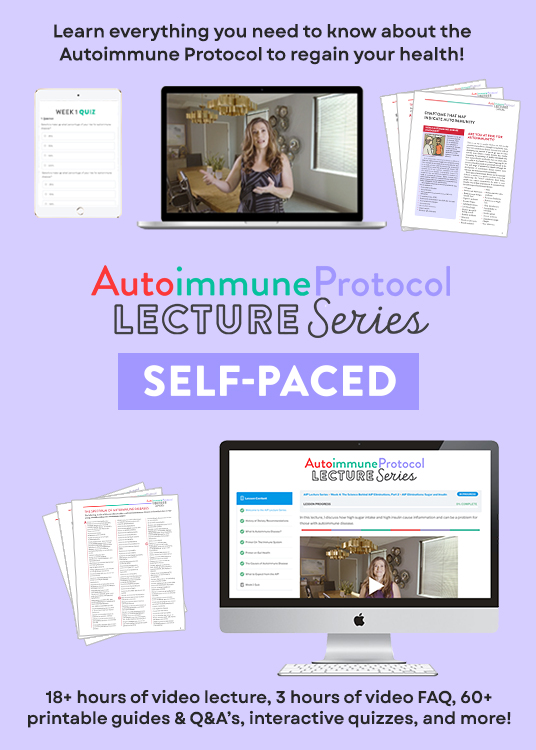
Reintroduction Phase
The AIP Elimination Phase includes cutting out those foods that are most likely to be holding back our health, but it’s not a life sentence. After a period of time, many (if not most) of the excluded foods, especially those that have nutritional merit despite also containing some (but not too much) potentially detrimental compounds, can be methodically challenged (where you test your tolerance to them) and reintroduced (where they make their way back into your regular diet). You can learn more about the Reintroduction Protocol in Reintroducing Foods after Following the Autoimmune Protocol.
The Reintroduction Phase is your opportunity to truly understand your body’s needs, identify your trigger foods, and hone in on your personalized optimal diet for lifelong health. Many people also test the boundaries of lifestyle factors during the Reintroduction Phase, further identifying what lifestyle priorities are most important to maintain their health and what they can let slide from time to time. You might also discuss with your healthcare provider the merits of discontinuing specific medications or supplements in this phase, if you feel that they might no longer be needed.
Some people find a comfort zone in the Elimination Phase, sometimes feeling so good that reintroductions aren’t tempting but also sometimes being afraid to lose ground should a food challenge trigger symptoms. I discussed this in detail AIP, Orthorexia and Food Phobia, but I do want to reiterate that the self-discovery process via methodical reintroductions is super important for finding balance and sustainability lifelong. Plus, successful reintroduction expands the diet, making all kinds of day-to-day challenges (like going to a potluck, eating in a restaurant, or travel) so much easier.
I want to reiterate: The AIP is not a life sentence, but rather a toolbox full of strategies for understanding how your body reacts to various foods, lifestyle and your environment, and methodologies for healing given your individual health challenges.
Maintenance Phase
The Autoimmune Protocol provides a framework for a health journey full of self-discovery, the goal of which is to discover your own personalized maintenance diet and lifestyle, defined as that collection of choices that keeps you healthy and which you feel you can sustain over the long term. I like to think of the Maintenance Phase as the empowerment that comes with having discovered your food triggers (the lines you can’t cross), what your body needs to thrive (your optimal choices), and what your body tolerates (your wiggle room).
Most of us seasoned AIP-ers who have gone through this process live somewhere in between what we know to be optimal and what we know we can’t tolerate, shifting back and forth within this range depending on the curve balls life throws at us. For example, if you’re traveling in a foreign country, you might choose to walk that line of what your body tolerates, in order to enjoy the widest variety of cultural dishes you can. And, if you catch a cold or the flu, you might realize that you need to dial in your diet and lifestyle to that optimal level to support recovery. This is also where the AIP as a toolkit metaphor comes back in (discussed in AIP, Orthorexia and Food Phobia) because sometimes a challenge will require going back to the AIP Elimination Phase in order to fully support recovery and healing.
Whether or not you call how you eat and live in this phase “AIP” is a matter of personal preference. Many people refer to this Maintenance Phase as modified AIP or AIP plus or AIP plus reintros. Others will think of this as graduating from the AIP.
The wonderful thing is that once you thoroughly understand the principles of the AIP, the why’s behind what to eat and what not to eat and the gray in between, in addition to progressing through your health journey to the Maintenance Phase, you are well-equipped to select those AIP tools you need to navigate any given situation, along with informed and judicious use of medical interventions. This is yet another reason why I have created such thorough educational resources for the AIP, because understanding the ins and outs of the Autoimmune Protocol is very helpful for arriving at this phase of your healing journey. As a reminder, you can get there via self-education (reading my books and/or the vast collection of articles on the AIP on my site, for example), 1-on-1 coaching (like working with an AIP Certified Coach), group coaching (like SAD to AIP in Six), or a virtual classroom (like my AIP Lecture Series).
My Personal AIP Maintenance Phase
 For those of you just starting out on your AIP journey, I thought it might be helpful to share what my diet and lifestyle look like now, 8 years after first learning about the Autoimmune Protocol.
For those of you just starting out on your AIP journey, I thought it might be helpful to share what my diet and lifestyle look like now, 8 years after first learning about the Autoimmune Protocol.
I tried my first reintroductions about 4 months after starting the AIP Elimination Phase. They mostly didn’t go well, so I pulled back and didn’t try again until I hit the 10-month mark. During that time, I focused on nutrient density (which I really hadn’t dialed in appropriately enough yet) and lifestyle (mainly sleep). The second time I tried reintroductions, they went much better. I was able to add seed-based spices, chocolate, and a few nuts and seeds to my diet. It took 15 months before I could successfully reintroduce coffee and over 3 years before I was able to reintroduce eggs, and even then, eggs were something I only tolerated occasionally. I learned that I’m incredibly sensitive to gluten, dairy and soy. The first few times I tried nightshades, I had awful flares that lasted months. Around the 3-year mark, I had hit a pretty stable diet: AIP plus nuts (except almonds), seeds (except nutmeg and black pepper), chocolate, coffee, cultured ghee, and occasional eggs, corn and rice (about once per week worked fine for me). I had learned that I really need to prioritize sleep and stress management and that I need to gauge on a daily basis what my energy levels are to dial in workout intensity.
When I started creating the AIP Lecture Series, which includes a whole week focused on troubleshooting, reintroductions, and mindset, I realized that I hadn’t even tried a reintroduction for years. I had grown comfortable, happy with the foods I could eat, and perhaps too scared of a flare to push my boundaries. But, as I was filming a lecture on the importance of reintroductions, I realized that I needed to revisit them myself and walk the walk, so to speak. So, I did. Now at the 5-year mark, foods that I thought I’d never be able to eat again didn’t trigger any ill effects whatsoever! I discovered that eggs, corn and rice were now fine for daily consumption (although I’m so used to more nutrient-dense breakfasts that I only eat eggs about twice per week, and I think of corn as a treat and rice as a filler food). I can eat bell peppers, potatoes and paprika again. I even ate tomatoes on vacation earlier this year with no ill effects! I’ve even reintroduced some non-Paleo foods, including lentils, chickpeas, split peas, and gluten-free oats (all really great for the gut microbiome, and yes, these reintroductions were motivated by the research I’m doing for my new microbiome book). And, I’ve discovered that, provided it’s soy-free and dairy-free, I can eat gluten-free baked goods with no ill effects (not that I do often, but it’s lovely wiggle room to have!). On the flip side, I’ve discovered that alcoholic beverages triggers my Raynaud’s, so I stick to sparkling water.
I’m so, so, so grateful to the AIP Lecture Series for motivating me to challenge more foods. You might describe my current diet as simply nutrient-dense, gluten-free, dairy-free, and soy-free. You could label it Paleo Plus, or AIP Plus, or 80/20. I think of myself as a nutrivore. My main criterion for the foods on my plate continues to be nutrient density. And lifestyle priorities continue to be super important for my health. I’m still using my AIP toolkit, but with both a deep understanding of my own body and the empowering knowledge that 8 years of healing has made it more resilient to suboptimal foods. It truly has been a journey.


